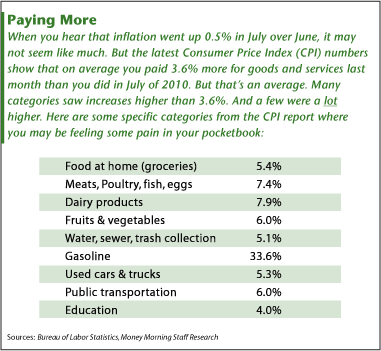Few are willing to acknowledge the threat of stagflation, but reports showing inflation rising more quickly than expected - even as growth is slowing - indicate that this scourge of the 1970s may be stalking the U.S. economy.
Every economic report nudges the United States closer to the definition of stagflation - a condition marked by slow economic growth, high unemployment, and soaring prices.
Although many economists believe the sluggish economy will moderate inflation, that's not what happened in the 1970s.
"The belief that you can't have inflation and high unemployment is nonsense; we had 25% inflation in the U.K. in 1975, in the middle of a recession," said Money Morning Global Investment Strategist Martin Hutchinson.
Hutchinson has repeatedly warned Money Morning readers that the U.S. Federal Reserve's easy money policies would lead to inflation without fostering economic growth.
In the past couple of months, Hutchinson's fears have been realized.
The Stark Reality
The July consumer price index (CPI), released yesterday (Thursday) by the U.S. Labor Department, increased 0.5% from June - more than double the 0.2% economists had expected.
The Labor Department's producer price index (PPI) report for July, which tracks what businesses pay for goods, rose 0.2% - also twice what economists had expected.
Economic growth, meanwhile, has been sluggish at best. The economy expanded by just 1.3% in the second quarter, following 0.4% growth in the first quarter. A healthy economy should have a gross domestic product (GDP) growth of 3% or higher.
Yesterday's weekly jobless claims report also inched higher, to 408,000, which suggests little progress is being made on reducing the 9.1% unemployment rate. What's more, the report showed hourly wages falling 0.1% in July and 1.3% from a year earlier, making it difficult even for those who have jobs to cope with the rising prices.
In yet another report yesterday, the Philadelphia Federal Reserve Bank said factory activity in the mid-Atlantic region fell from +2 in July to -30.7 in August - its lowest level since March 2009. Readings below zero indicate shrinking manufacturing activity.
If the Fed and government lawmakers continue to ignore the threat of stagflation - Fed Chairman Ben S. Bernanke has repeatedly downplayed inflation concerns - the stage will be set for a long and painful climb out of a deep economic morass.
"When this happened before -- back in the 1972-73 time frame -- it took a full decade of punishingly high interest rates and the commitment of a Fed chairman named Paul A. Volcker to solve," Hutchinson said.
Numbers Games
Chairman Bernanke tends to brush aside the usually higher overall CPI number in favor of the so-called "core" inflation number that excludes food and fuel costs. In July core inflation rose just 0.2%, far less than the 0.5% jump in the overall CPI.
Food and fuel, along with clothing, have been among the categories showing the highest increases. The government excludes them because it says their volatile price swings skew its data, but average Americans can't exclude those daily necessities from their budgets.
"The CPI is a joke," Money Morning Chief Investment Strategist Keith Fitz-Gerald said earlier this year. "Every American knows that in reality it's far higher than that based on what they feel in their wallets every day."
Furthermore, the numbers are more often reported as changes from the previous month as opposed to the previous year, which softens their impact. The CPI has risen 3.6% in the past 12 months, for example.

In fact, the annual numbers in several individual categories show why so many middle-class Americans are struggling to make ends meet. The price of gasoline, for example was up 33.6% over last July and fuel oil up 37.2%. The "food at home" category, which is mostly groceries, was up 5.4%, with dairy products up 7.9%.
The PPI is up 7.2% from last July, which means businesses have eaten some price increases rather than pass them on to customers. Going forward, businesses either will have to raise prices further - adding to consumer inflation - or will have to accept lower profits. Both options would be bad for the economy.
Fed Failure
The Fed - which is charged with keeping inflation in check - has not taken such numbers into consideration as it has held interest rates near zero and embarked on "quantitative easing" policies that have flooded the markets with money.
In effect, the Fed is pouring gasoline on a fire that it should be extinguishing.
"Ultra-low interest rates and excess money supply growth are what's been driving inflation," Hutchinson said. "They raise commodity prices, which over time feeds into inflation in general."
The threat of stagflation paints a dark picture of the fate of the U.S. economy in the months and even years ahead.
It's a grim landscape of high unemployment and companies treading water while the Fed declines to reverse course. In such a scenario, Hutchison believes inflation could go beyond 1970s levels.
"Once inflation takes off, there's nothing holding it to the 10% level it peaked at in the late 1970s," Hutchinson said. "Bernanke's "no interest rate hike till 2013' will look very silly as inflation zooms higher."
News and Related Story Links:
- Money Morning:
Two Easy Ways to Save Your Wealth From 1970s-Style Stagflation - Money Morning:
"Stealth QE3" Comes to Fruition - Soaring Inflation is Next - Money Morning:
Helicopter Ben is at It Again: Four Ways to Protect Yourself From the Fed's Next Flyover - Money Morning:
Sorry Mr. Bernanke: ThereWillbe a Double-Dip Recession - MarketWatch:
Producer prices climb hotter-than-forecast 0.2% - Bloomberg News:
U.S. Consumer Prices Rise More Than Forecast - Reuters:
Regional factory activity hits 2-1/2 year low - Associated Press:
Consumer prices rose by the most since March - Wikipedia:
Stagflation - Bureau of Labor Statistics:
Consumer Price Index
About the Author
David Zeiler, Associate Editor for Money Morning at Money Map Press, has been a journalist for more than 35 years, including 18 spent at The Baltimore Sun. He has worked as a writer, editor, and page designer at different times in his career. He's interviewed a number of well-known personalities - ranging from punk rock icon Joey Ramone to Apple Inc. co-founder Steve Wozniak.
Over the course of his journalistic career, Dave has covered many diverse subjects. Since arriving at Money Morning in 2011, he has focused primarily on technology. He's an expert on both Apple and cryptocurrencies. He started writing about Apple for The Sun in the mid-1990s, and had an Apple blog on The Sun's web site from 2007-2009. Dave's been writing about Bitcoin since 2011 - long before most people had even heard of it. He even mined it for a short time.
Dave has a BA in English and Mass Communications from Loyola University Maryland.



